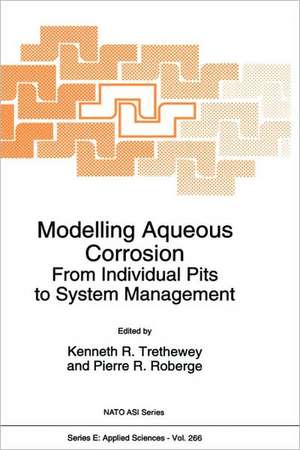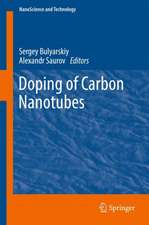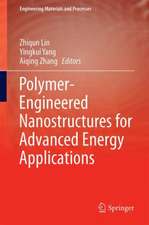Modelling Aqueous Corrosion: From Individual Pits to System Management: NATO Science Series E:, cartea 266
Editat de Kenneth R. Threthewey, Pierre R. Robergeen Limba Engleză Hardback – 30 apr 1994
This book focuses on the models, rather than the computing, which have been made possible during the past decade. Aimed at all those with an interest in corrosion and its control, the book draws together the range of new modelling strands, suggests new avenues of approach and generates further momentum for improvements to corrosion management, whether by increased understanding of atomistic processes or by control of large plant.
| Toate formatele și edițiile | Preț | Express |
|---|---|---|
| Paperback (1) | 1819.10 lei 6-8 săpt. | |
| SPRINGER NETHERLANDS – 16 oct 2012 | 1819.10 lei 6-8 săpt. | |
| Hardback (1) | 1825.40 lei 6-8 săpt. | |
| SPRINGER NETHERLANDS – 30 apr 1994 | 1825.40 lei 6-8 săpt. |
Din seria NATO Science Series E:
- 24%
 Preț: 1570.70 lei
Preț: 1570.70 lei -
 Preț: 397.76 lei
Preț: 397.76 lei -
 Preț: 386.81 lei
Preț: 386.81 lei - 20%
 Preț: 346.24 lei
Preț: 346.24 lei -
 Preț: 424.33 lei
Preț: 424.33 lei - 18%
 Preț: 1224.18 lei
Preț: 1224.18 lei - 18%
 Preț: 1836.63 lei
Preț: 1836.63 lei - 18%
 Preț: 1229.28 lei
Preț: 1229.28 lei -
 Preț: 381.00 lei
Preț: 381.00 lei -
 Preț: 409.30 lei
Preț: 409.30 lei - 18%
 Preț: 1841.36 lei
Preț: 1841.36 lei - 5%
 Preț: 367.28 lei
Preț: 367.28 lei -
 Preț: 407.19 lei
Preț: 407.19 lei - 18%
 Preț: 1838.38 lei
Preț: 1838.38 lei -
 Preț: 420.28 lei
Preț: 420.28 lei -
 Preț: 399.29 lei
Preț: 399.29 lei -
 Preț: 398.74 lei
Preț: 398.74 lei - 18%
 Preț: 3026.13 lei
Preț: 3026.13 lei -
 Preț: 388.90 lei
Preț: 388.90 lei - 5%
 Preț: 391.06 lei
Preț: 391.06 lei - 18%
 Preț: 1228.62 lei
Preț: 1228.62 lei - 18%
 Preț: 1229.73 lei
Preț: 1229.73 lei - 18%
 Preț: 1234.46 lei
Preț: 1234.46 lei - 5%
 Preț: 3532.05 lei
Preț: 3532.05 lei - 18%
 Preț: 1840.11 lei
Preț: 1840.11 lei - 5%
 Preț: 378.80 lei
Preț: 378.80 lei - 18%
 Preț: 1227.84 lei
Preț: 1227.84 lei -
 Preț: 392.75 lei
Preț: 392.75 lei -
 Preț: 395.63 lei
Preț: 395.63 lei - 18%
 Preț: 2489.30 lei
Preț: 2489.30 lei - 5%
 Preț: 1429.27 lei
Preț: 1429.27 lei -
 Preț: 396.02 lei
Preț: 396.02 lei - 5%
 Preț: 2142.61 lei
Preț: 2142.61 lei - 18%
 Preț: 3049.16 lei
Preț: 3049.16 lei - 18%
 Preț: 1844.54 lei
Preț: 1844.54 lei -
 Preț: 403.53 lei
Preț: 403.53 lei
Preț: 1825.40 lei
Preț vechi: 2226.11 lei
-18% Nou
Puncte Express: 2738
Preț estimativ în valută:
349.31€ • 367.30$ • 288.62£
349.31€ • 367.30$ • 288.62£
Carte tipărită la comandă
Livrare economică 16-30 aprilie
Preluare comenzi: 021 569.72.76
Specificații
ISBN-13: 9780792328209
ISBN-10: 0792328205
Pagini: 468
Ilustrații: VIII, 468 p.
Dimensiuni: 155 x 235 x 27 mm
Greutate: 0.85 kg
Ediția:1994
Editura: SPRINGER NETHERLANDS
Colecția Springer
Seria NATO Science Series E:
Locul publicării:Dordrecht, Netherlands
ISBN-10: 0792328205
Pagini: 468
Ilustrații: VIII, 468 p.
Dimensiuni: 155 x 235 x 27 mm
Greutate: 0.85 kg
Ediția:1994
Editura: SPRINGER NETHERLANDS
Colecția Springer
Seria NATO Science Series E:
Locul publicării:Dordrecht, Netherlands
Public țintă
ResearchCuprins
“Protectiveness of corrosion layers”.- “Mathematical modelling of localized corrosion”.- “Modelling corrosion in nuclear systems”.- “Modelling the adsorption of organic corrosion inhibitors on metal surfaces”.- “The use of acoustic emission for the study and monitoring of localized corrosion phenomena”.- “Expert systems for corrosion prevention and control”.- “Anodic dissolution of metal coated by a formed salt film”.- “The respective effects of passive films and non-metallic inclusions on the pitting resistance of stainless steels — consequences on the pre-pitting noise and the anodic current transients”.- “Modelling the corrosion of zirconium alloys in nuclear reactors cooled by high temperature water”.- “Modelling procedures for predicting the lifetimes of nuclear waste containers”.- “Mechanism of stress corrosion cracking and corrosion fatigue of precipitation hardening aluminium alloys”.- “Medium aggressivity and inhibitive species in pitting corrosion and stainless steels”.- “Modelling the capacitive behaviour of the passive film”.- “Relationship between modelled turbulence parameters and corrosion product film stability in disturbed single-phase aqueous flow”.- “Modelling of CO2 corrosion mechanisms”.- “Factors affecting the corrosion resistance of materials under irradiation in the early stage of growth of the passive films”.- “Modelling of electrochemical noise due to the activation-controlled dissolution of metals”.- “A systematic approach to the design of warship impressed current cathodic protection systems”.- “Eliciting corrosion knowledge through the fault-tree eyeglass”.- “New methods of quantitative analysis of localized corrosion using scanning electrochemical probes”.-“Towards improved quantitative characterization of corroding surfaces using fractal models”.
















